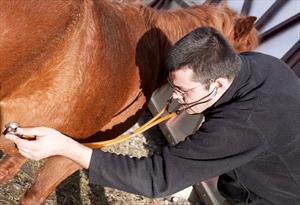All animals come with defense mechanisms. Humans use sarcasm, pepper spray, and inappropriate humor. Dogs use teeth; cats use claws...

Photo courtesy of BigStock
I once read a statement from a fellow equine practitioner saying that he fully expected the last words he would ever hear to be “Don’t worry, Doc. She doesn’t kick.” If by some miracle he lived, he anticipated that the follow-up statement would be “Wow! She’s never done that before."
Most equine veterinarians and farriers will tell you that they have never been kicked by a horse that kicks. I know small animal practitioners who comment that they have never been bitten by a dog that bites. The assurances cross the species spectrum, but the answers boil down to two possibilities:
- All animal-related injuries are flukes.
- Any animal is capable of inflicting damage under the right circumstances.
Call me crazy (you won’t be the first), but I’m inclined to attribute the incidents of injuries caused by sweet, cuddly, fluffy innocents to the latter logic.
“Not my Pookie!” you say. Well, no, of course not Pookie. He’s the best-trained hippopotamus on the planet, and it’s perfectly okay to have him sit on your titanium-reinforced couch with you to watch Top Chef. But those other dogs, cats, horses, birds, goats, cattle, and sea slugs can be quite problematic sometimes.
The danger zone for most animal professionals lies in that phrase “the right circumstances.” Animals are ‒ shhh, don’t tell them I said this – animals. All animals come with defense mechanisms. Humans use sarcasm, pepper spray, and inappropriate humor. Dogs use teeth; cats use claws; birds use beaks and talons; horses use hooves and teeth; goats and cattle use horns and hooves. All of these defenses are designed to protect the bearer under threatening circumstances.
Unfortunately, and to my mind unreasonably, most animals view needles, cold exam tables, the smell of blood or disinfectant, loud equipment, and unrequested poking and prodding as threatening circumstances. Most of us who face the fangs, claws, hooves, and assorted other sharp objects daily recognize this reality and take steps to minimize the need for flight or fight on the part of any of the involved parties.
However, a number of owners take umbrage at the mere suggestion that their animal is suspected of potential malfeasance.
Now, we know Pookie. We love Pookie, although, we think that the polka-dot sweater is a bit much. Pookie is the best-behaved, most intelligent hippo ever. However, he really doesn’t like having that thermometer stuck you-know-where. While we can’t blame Pookie, it causes some serious problems with our worker’s compensation provider when he keeps sitting on technicians. The next time Pookie visits, he will need to go into the hippo stanchion. Don’t take offense. While there may be some flexibility, generally, this is the preferred order of priority:
- Human safety
- Animal safety and health
- Animal comfort
- Human comfort
That muzzle may not look comfortable, but it will allow veterinarians, technicians, and groomers to keep their primary instruments - hands - intact. A shot of sedation may pinch the pocketbook, but may keep your horse from dismantling the vet or farrier.
And if your veterinarian asks you to move out of range or tells you that a certain action, such as cradling your seizing horse’s head in your lap (I’ve seen it!), is unsafe, for goodness sake, LISTEN! Among our other nifty skills, veterinarians are trained to recognize cues that signal aggressive or agitated behaviors on the part of our patients. We also recognize that biting, scratching, or stampeding doesn’t make an animal “bad,” just human. Oh, wait…
And remember, safety measures such as muzzles, stanchions, tranquilizers, etc. preserve your animal’s safety and well-being as well as that of the two-legged mammals. If the stanchion keeps Pookie from sitting on the technician, it also keeps the thermometer from becoming lodged someplace detrimental to Pookie. Cats may feel more secure snugly wrapped in a towel or cat-bag as they don’t actually enjoy having legs and claws flying everywhere, and will be less likely to injure themselves if properly restrained. A horse that panics during a procedure is as likely to injure himself by slipping or bolting through a fence as he is the humans in his path. When an animal professional decides to implement a safety protocol, that decision is based on experience and judgment, and protects the safety of ALL of the animals involved.
We don’t mind hearing Pookie grumble a bit about the hippo stanchion and we know you don’t like seeing Rover in a muzzle or Silver’s tranquilized nose drooping. But we would mind terribly if the last words we heard or that you said were “Don’t worry…”
1 Comment